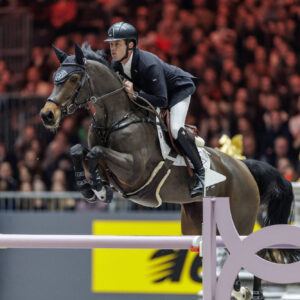How many of us have had the image of the Training Pyramid ground into memory? Whatever our sport, if we are any good at it and wish our horses to be any good at it, then this “Pyramid” or “Scale” plays a necessary role in building the fundamentals needed for correct and quality performance. But the thing is, it is hard to figure out the progression from Rhythm to Collection and when your horse is ready to move on, and when he should take a step back. Trainer and Scottish dressage champion Sue Grice thought so, too, so she developed a revised model in the form of a spiral that made more sense to her and her students, and that showed positive results in both training and the show ring. In this excerpt from her book The Training Spiral, Sue breaks it down for us.
***
Although the traditional pyramid concept of the Scales of Training clearly has a place within equestrianism, it is my contention that it does not provide the most helpful framework for applying the elements of the Scales. In the following pages I would like to propose a different model—a Training Spiral.
Before going any further, consider for a moment what the word ”scale” actually means. It has various meanings in the English language, including:
- A set of marks or numbers used to measure the size or level of something.
- The relation between the real size of something and its size on a map or model.
- The relative level or extent of something. A machine or device for weighing people or things.
- A set of musical notes played in ascending or descending order.
- To climb something steep, such as a mountain or ladder.
While some of these meanings may appear irrelevant to training horses, all are worth a little thought. Most obviously, the idea of “scaling” something steep via a series of steps fits well with the pyramid structure most of us are familiar with. The notion of a scale as a means of measuring something, such as progress or attainment, also seems appropriate. If you open a thesaurus and look up synonyms for the word “scales,” you will find some more interesting terms: balances, gauges, measures, gradations, hierarchies, tiers.
In my view, the scales used in training a horse should be more like the gentle gradations or tiers of a spiral than a series of steps leading straight up from the base to the peak of a pyramid. The idea of “scales” of music—often undertaken as a practice exercise—is also very suggestive. The spiral model that I propose is based upon the traditional Scales of Training but enables a more gradual progression from one tier to the next, as the horse’s training proceeds.
The basic idea of the Training Spiral is that you can progress through all the elements of the Scales in order (Rhythm, Suppleness, Contact, Impulsion, Straightness, Collection), without having to perfect each one before attempting the next. Instead, each element is completed to the degree that the horse can manage at his given level of training. As soon as one cycle of this training—one tier of the spiral—is completed, the next can begin—only in this new cycle (Tier 2), the degree of difficulty or quality expected is increased.
Riders of all levels and with different aims and ambitions can utilize the Training Spiral as it is applicable to anyone seeking to improve their horse’s way of going, even if they are not aiming as high as Grand Prix and even if they focus on a horse sport other than dressage. The Training Spiral can be applied over many different time frames—for example, over a five-minute section of a single training session, or over the period of a week’s training, or over the course of months of training.

As an example, let’s consider a time scale of several years, assuming a horse is starting at Introductory Level and progressing to Third Level. In the Spiral, each tier represents the progression of the horse to his next level of training. In this example, the first tier represents the horse’s journey through Introductory Level, the second tier his journey through Training Level, the third tier his journey through First Level, and so on until he is at the “top” of the Spiral, which in this case is Third Level.
The horse begins at the bottom of the Spiral at Introductory Level and, as his training progresses, he moves up the tiers of the spiral, improving each of the six elements of the scales of training in the following order (Rhythm, Suppleness, Contact, Impulsion, Straightness, Collection) to an acceptable degree for the stage the horse is training at, before progressing to the next tier. There he will again work to improve each of the six elements (in order), but this time to a higher degree of quality than he did in the previous tier. This process is repeated again and again as the horse gradually improves and progresses by focusing on each of the elements of the Scales of Training, one at a time, and at an appropriate degree of difficulty for his level. In the case of the Introductory Level horse, each tier might take perhaps a year or so to establish to a satisfactory standard before progressing on to the next tier as horse and rider progress to Third Level.
Obviously, the degree of difficulty or quality expected is different at each level. For example, the degree of Collection shown by a horse at the Introductory Level may simply be that he is no longer “diving” onto his forehand, whereas when a horse is trained to a more advanced level, such as Grand Prix, you expect to see a much higher degree of Collection—for example, the ability to perform passage and piaffe. Whatever your horse’s breed and whatever your discipline, the aim should be that at each tier of the Training Spiral the six elements of the Scales become increasingly accomplished, and the horse able to perform more difficult movements and exercises while still maintaining the quality in each of the elements.

This excerpt from The Training Spiral by Sue Grice is reprinted with permission from Trafalgar Square Books (www.HorseandRiderBooks.com).


 May 11, 2023
May 11, 2023 



























